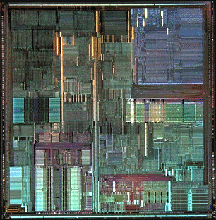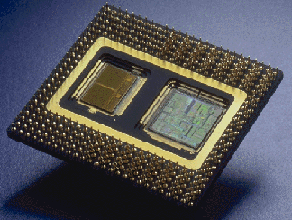


Intel had produced four bit and eight bit Microprocessor chips in the 1970's and it started it's 16 bit family of microprocessor chips with the 8086 chip and the family has developed through five generations to date. The family ranges from 16 bit processors to 64 bit processors. The first sixteen bit chips from Intel were the 8086 and 8088 processors..
The 8086 processor has a sixteen bit external data bus but the 8088 only has a eight bit external data bus. The processors data bus is sixteen bits inside the processor but it only communicates with the outside world through an eight bit data bus. IBM used the 8088 processor in it's PC computer because it was easier to use with the cheaply available eight bit support chips of the day. These support chips were designed for eight bit processors and were in common use in the industry. The IBM PC accessed the outside world via the bus connectors, eight bits at a time. Some "other" DOS computer manufacturers used the 8086 processor and accessed the memory sixteen bits at at time, achieving faster memory access. This was not common, most PC/XT type computers from manufacturers other and IBM also used the 8088 chip.
The 80286 processor was the first Intel processor to allow access to more than one Meg of memory. This processor has a 16 bit internal and external data bus and a 24 bit address bus. the 24 bit address bus means it can address up to 16 MBytes of memory.
| Processor | Int. Data Bus | Ext. Data Bus | Address Bus | Notes |
|---|---|---|---|---|
| 8086 | 16 bit | 16 bit | 20 bit | Used in some DOS computers |
| 8088 | 16 bit | 8 bit | 20 bit | Used in IBM PC |
| 80286 | 16 bit | 16 bit | 24 bit | Used in IBM AT |
| 80386DX | 32 bit | 32 bit | 32 bit | |
| 80386SX | 32 bit | 16 bit | 24 bit | |
| 80486DX | 32 bit | 32 bit | 32 bit | Built in co-processor |
| 80486SX | 32 bit | 32 bit | 32 bit | No co-processor |
| Pentium (Classic) | 64 bit | 64 bit | 32 bit |
The next generation of the Intel Family of processors was the Pentium Pro (once called the P6) processor, followed by the Pentium II and Celeron. The original Pentium, now called the Pentium Classic, was replaced by the Pentium MMX, a development of the original Pentium processor, with extra instructions for Multi Media processing. Here is a list of the various generations of Intel processors and the number of devices in each chip.
Processor |
Number of devices |
| 8086/8088 | 29,000 | 80286 | 134,000 |
| 80386DX | 275,000 |
| 80486DX | 1,300,000 |
| Pentium Classic | 3,100,000 to 3,400,000 |
| Pentium MMX | 4,500,000 |
| Pentium Pro | 6,500,000 in the core 15.5 million to 62 million in the cache |


80386DX
Features true 32 bit performance, with 32 bit internal and external data busses and a 32 bit address bus. 386 DX chips were available in clock speeds of 25 to 40Mhz.
80386SX
The low-cost, low-performance member of the 386 family. Was available in clock speeds or 16 to 33MHz. It featured a 32-bit internal data path, and a 16-bit external data bus. The address bus was only 24 bits, making it really an improved "286" processor. The cut-down busses allowed manufacturers to trim the cost of the system board's support circuitry.
80486DX
Improved design gave the 486 processors significant improvements in processor and memory
performance over the 386 devices. A 486DX/33 turned in processor performance about 85 percent better than, and memory performance more than double that of, a 386DX/33 chip.
486DX chips feature true 32 bit data and address busses and an internal floating point unit (maths co-processor). Available in clock speeds of 25 and 33MHz from Intel and up to 40MHz from AMD.
80486SX
This is essentially a 486DX without the internal FPU. Available in clock speeds of 16, 25 and 33MHz from Intel.
80486DX2
This was the first Intel family processor where the chip operated at a faster speed inside, than the clock signal supplied by the bus. It was a 486DX device that ran internally at twice the speed of the clock signal applied to it. The 66MHz 486DX2/66, used a 33-MHz bus clock and ran internally at 66MHz. These were available in DX2/50 and DX2/66 versions from Intel and AMD and Cyrix had DX2/80 versions also.
486DX4/100
The clock speed is tripled inside the processor and so a 486DX4/100 uses a 33Mhz bus clock and runs internally at 100MHz. Intel provided a 486DX4/100 device and AMD also had a DX4/120 device available.
Intel-compatible 486 CPU's
Manufacturers who made Intel-compatible processors included, Cyrix, IBM, Advanced Micro Devices (AMD) and Chips & Technologies. The 486DX, 486DX2 and 486DX4 processors from these manufacturers were considerably cheaper than the real INTEL device. Some suppliers and users were of the opinion these "other brand" processors are were as reliable as the INTEL product.
Important
The 486DX2 and 486DX4 processors from these "other manufacturers" have different timing and control signal requirements to the Intel devices and will usually only operate in system boards with jumpers to configure the board, for the requirements of each particular device.
Pentium
This is the first 64-bit processor from Intel and it uses RISC techniques internally and has an 8K data cache and an 8K code (instruction) cache. The Pentium also has an inbuilt floating point unit. The Pentium has a 64 bit internal and external data path and a 32 bit address bus. Pentium processors have been available with Clock speeds from 60 to 200MHz. It does not take long for a particular speed Pentium to become obsolete, and no longer available. With the introduction of the MMX enhancements to the Pentium, the original Pentium is now called the Pentium Classic.
Pentium OverDrive
These chips are 486 chips incorporating some of the Pentium technology. These chips have a 64 bit internal data bus and a 32 bit external data bus. They are intended to plug into system boards in place of a 486DX chip. The OverDrive concept has had a very short production life as upgrading in this way is not cost effective.
There are other manufacturers who produce Pentium and Pentium OverDrive type processors but due to the copywrite on the name Pentium, they must use names like 586 and 686 for their devices.
| Pentium Classic and Pentium with MMX Celeron and Celeron A |
| Back to the opening index | Book one index |